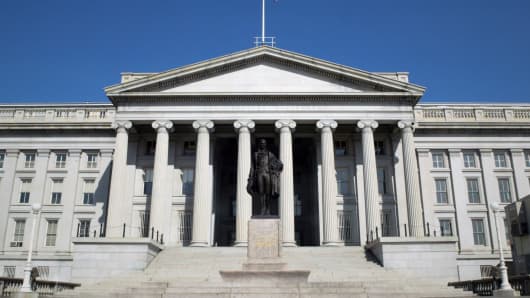U.S. Treasurys prices rose on Friday as lower stock prices and an unexpected drop in March U.S. consumer sentiment enhanced the allure of safe-haven U.S. government debt.
With $66 billion of new debt supply out of the way this week, investors were also moving to take advantage of yields hovering near the highest in almost a year, analysts said.
Prices rose on Friday after the Thomson Reuters/University of Michigan's preliminary reading on the overall index on consumer sentiment for early March tumbled to the lowest reading since December 2011.
"We're past the auctions, we're still near the highest yields in roughly a year, which are levels that are appealing to some investors, and the confidence numbers are buoying the market,'' said David Coard, head of fixed income sales and trading at The Williams Capital Group in New York.
Ten-year U.S. Treasury notes on Friday traded 11/32 higher in price to yield 2.00 percent, down from 2.04 percent late Thursday. Yields remain not far off the 11-month high of 2.09 percent reached late last week after data showing stronger-than-expected U.S. jobs growth in February.
The Treasury this week sold three-year and 10-year notes as well as 30-year bonds, and investors were buying to absorb the supply, Coard said.
Treasurys were also generally supported by expectations the Federal Reserve will continue to buy assets over the near term in an effort to prop up the economy.
The Fed will hold its next policy meeting on Tuesday and Wednesday.
While recent, improved data on the labor market and retail sales have fueled optimism on economic growth, some investors say there has not been enough evidence of a recovery to spur Fed officials to scale back their program of buying $85 billion per month of mortgage-backed securities and Treasurys.
"The doves on the committee will unequivocally want to see more progress made on the employment backdrop before they even contemplate tightening the reins on the latest round" of quantitative easing, said Michael Cloherty, head of U.S. rates strategy at RBC Capital Markets in New York.
The Fed will issue its policy statement at the close of the two-day meeting on Wednesday, and Fed Chairman Ben Bernanke is expected to conduct a press conference afterwards.
"There won't be any dramatic change,'' said Richard Schlanger, portfolio manager at Pioneer Government Income Fund, at Boston-based Pioneer Investments, a firm with $200 billion in assets under management. "It's still steady as she goes. The Fed's bond-buying program will remain in effect in its current strength.''
Schlanger said he expected the Fed to acknowledge improvement in housing, auto sales and job growth.
"But the Fed wants sustained progress,'' he said. If the unemployment rate drops because the work force has shrunk, the Fed wants to know people have left the work force out of choice, not because they have given up on finding a job, Schlanger said.
For the first time in over a year, the U.S. Treasury Department on Friday asked institutions holding a large amount of benchmark Treasury notes to provide information on their positions -- following a week in which there was unusual activity in market. The Treasury called for "large position reports'' from entities holding positions in 2 percent notes maturing in February 2023 of at least $2 billion at the close of business on March 11.
Traders said the Treasury sought the information on concerns over disruptions in the market for government securities after a huge jump in the number of trades that could not be completed, or fails, earlier this week. Treasury officials said the market experienced about $80 billion in fails on Monday, five times more than the average over the last year, according to Depository Trust and Clearing Corp. data.
Treasury yields are rate benchmarks and the securities serve as collateral for many outstanding loans in financial markets.
The rate for lending securities in the overnight repurchase, or repo, market, normally about 20 basis points, fell into negative territory on Monday due to a shortage of 10-year notes due February 2023. The reason for the shortage was unclear.
The shortage caused some disruption in the short-term funding market, according to traders.
"The 10-year had been trading extremely tight in repo for a while,'' said John Canavan, fixed income analyst at Stone & McCarthy Research Associates. "It eased quite a bit this morning, but the Treasury was trying to get a handle on the circumstances behind the activity."


